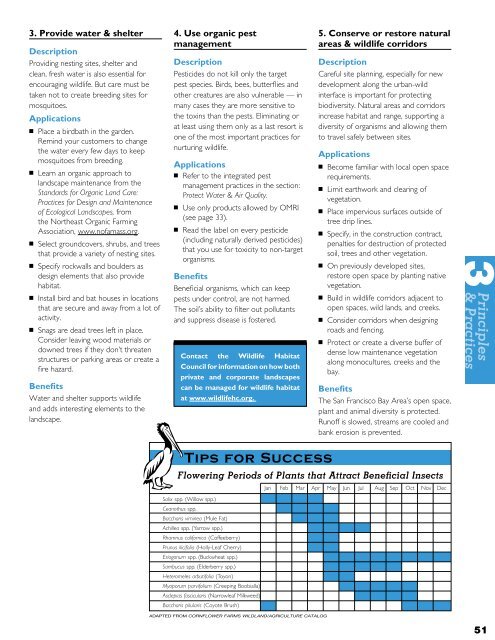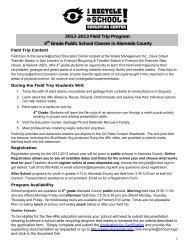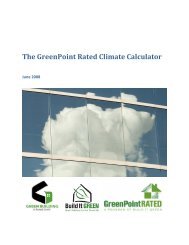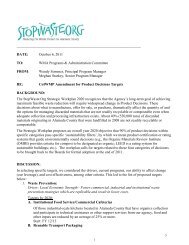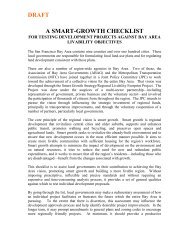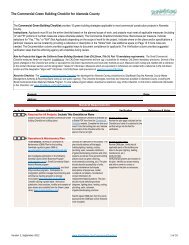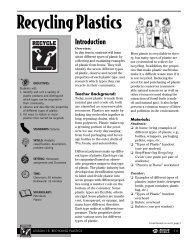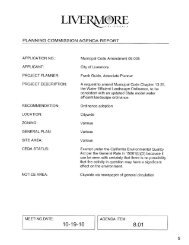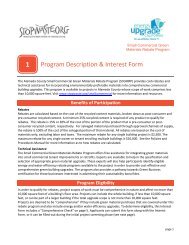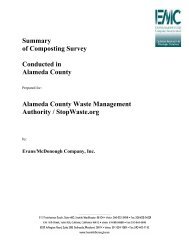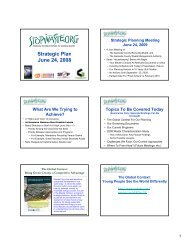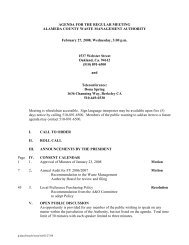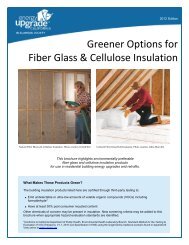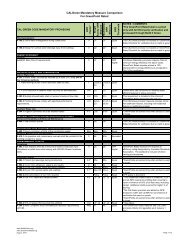Bay-Friendly Landscaping Principles and Practices - StopWaste.org
Bay-Friendly Landscaping Principles and Practices - StopWaste.org
Bay-Friendly Landscaping Principles and Practices - StopWaste.org
You also want an ePaper? Increase the reach of your titles
YUMPU automatically turns print PDFs into web optimized ePapers that Google loves.
3. Provide water & shelter<br />
Description<br />
Providing nesting sites, shelter <strong>and</strong><br />
clean, fresh water is also essential for<br />
encouraging wildlife. But care must be<br />
taken not to create breeding sites for<br />
mosquitoes.<br />
Applications<br />
n Place a birdbath in the garden.<br />
Remind your customers to change<br />
the water every few days to keep<br />
mosquitoes from breeding.<br />
n Learn an <strong>org</strong>anic approach to<br />
l<strong>and</strong>scape maintenance from the<br />
St<strong>and</strong>ards for Organic L<strong>and</strong> Care:<br />
<strong>Practices</strong> for Design <strong>and</strong> Maintenance<br />
of Ecological L<strong>and</strong>scapes, from<br />
the Northeast Organic Farming<br />
Association, www.nofamass.<strong>org</strong>.<br />
n Select groundcovers, shrubs, <strong>and</strong> trees<br />
that provide a variety of nesting sites.<br />
n Specify rockwalls <strong>and</strong> boulders as<br />
design elements that also provide<br />
habitat.<br />
n Install bird <strong>and</strong> bat houses in locations<br />
that are secure <strong>and</strong> away from a lot of<br />
activity.<br />
n Snags are dead trees left in place.<br />
Consider leaving wood materials or<br />
downed trees if they don’t threaten<br />
structures or parking areas or create a<br />
fire hazard.<br />
Benefits<br />
Water <strong>and</strong> shelter supports wildlife<br />
<strong>and</strong> adds interesting elements to the<br />
l<strong>and</strong>scape.<br />
4. Use <strong>org</strong>anic pest<br />
management<br />
Description<br />
Pesticides do not kill only the target<br />
pest species. Birds, bees, butterflies <strong>and</strong><br />
other creatures are also vulnerable — in<br />
many cases they are more sensitive to<br />
the toxins than the pests. Eliminating or<br />
at least using them only as a last resort is<br />
one of the most important practices for<br />
nurturing wildlife.<br />
Applications<br />
n Refer to the integrated pest<br />
management practices in the section:<br />
Protect Water & Air Quality.<br />
n Use only products allowed by OMRI<br />
(see page 33).<br />
n Read the label on every pesticide<br />
(including naturally derived pesticides)<br />
that you use for toxicity to non-target<br />
<strong>org</strong>anisms.<br />
Benefits<br />
Beneficial <strong>org</strong>anisms, which can keep<br />
pests under control, are not harmed.<br />
The soil’s ability to filter out pollutants<br />
<strong>and</strong> suppress disease is fostered.<br />
Contact the Wildlife Habitat<br />
Council for information on how both<br />
private <strong>and</strong> corporate l<strong>and</strong>scapes<br />
can be managed for wildlife habitat<br />
at www.wildlifehc.<strong>org</strong>.<br />
5. Conserve or restore natural<br />
areas & wildlife corridors<br />
Description<br />
Careful site planning, especially for new<br />
development along the urban-wild<br />
interface is important for protecting<br />
biodiversity. Natural areas <strong>and</strong> corridors<br />
increase habitat <strong>and</strong> range, supporting a<br />
diversity of <strong>org</strong>anisms <strong>and</strong> allowing them<br />
to travel safely between sites.<br />
Applications<br />
n Become familiar with local open space<br />
requirements.<br />
n Limit earthwork <strong>and</strong> clearing of<br />
vegetation.<br />
n Place impervious surfaces outside of<br />
tree drip lines.<br />
n Specify, in the construction contract,<br />
penalties for destruction of protected<br />
soil, trees <strong>and</strong> other vegetation.<br />
n On previously developed sites,<br />
restore open space by planting native<br />
vegetation.<br />
n Build in wildlife corridors adjacent to<br />
open spaces, wild l<strong>and</strong>s, <strong>and</strong> creeks.<br />
n Consider corridors when designing<br />
roads <strong>and</strong> fencing.<br />
n Protect or create a diverse buffer of<br />
dense low maintenance vegetation<br />
along monocultures, creeks <strong>and</strong> the<br />
bay.<br />
Benefits<br />
The San Francisco <strong>Bay</strong> Area’s open space,<br />
plant <strong>and</strong> animal diversity is protected.<br />
Runoff is slowed, streams are cooled <strong>and</strong><br />
bank erosion is prevented.<br />
3 <strong>Principles</strong><br />
& <strong>Practices</strong><br />
Tips for Success<br />
Flowering Periods of Plants that Attract Beneficial Insects<br />
Jan Feb Mar Apr May Jun Jul Aug Sep Oct Nov Dec<br />
Salix spp. (Willow spp.)<br />
Ceanothus spp.<br />
Baccharis viminea (Mule Fat)<br />
Achillea spp. (Yarrow spp.)<br />
Rhamnus californica (Coffeeberry)<br />
Prunus ilicifolia (Holly-Leaf Cherry)<br />
Eriogonum spp. (Buckwheat spp.)<br />
Sambucus spp. (Elderberry spp.)<br />
Heteromeles arbutifolia (Toyon)<br />
Myoporum parvifolium (Creeping Boobialla)<br />
Asclepias fascicularis (Narrowleaf Milkweed)<br />
Baccharis pilularis (Coyote Brush)<br />
ADAPTED FROM CORNFLOWER FARMS WILDLAND/AGRICULTURE CATALOG<br />
51


